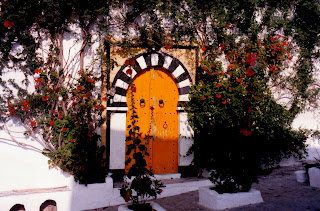Itinerant's Itinerary: El Camino del Diablo - the road not taken
Two roads diverged in a yellow wood,
And sorry I could not travel both
And be one traveler, long I stood
And looked down one as far as I could
To where it bent in the undergrowth;
Then took the other, as just as fair,
And having perhaps the better claim
Because it was grassy and wanted wear,
Though as for that the passing there
Had worn them really about the same,
And both that morning equally lay
In leaves no step had trodden black.
Oh, I marked the first for another day!
Yet knowing how way leads on to way
I doubted if I should ever come back.
I shall be telling this with a sigh
Somewhere ages and ages hence:
Two roads diverged in a wood, and I,
I took the one less traveled by,
And that has made all the difference.
- The Road Not Taken, Robert Frost
 |
| Two roads diverged ... |
I haven't even begun my Discovery Ride in Arizona with its theme of immigration, and I'm already regretting the road not taken. When first planning my trip, I wanted to travel the Camino del Diablo, or the Devil's Highway, along the Arizona-Mexico border, but as it happens, I couldn't take that road.
Part of the inspiration for my trip was the book The Devil's Highway by Luis Urrea.
 |
| The Devil's Highway by Luis Alberto Urrea |
A finalist for the Pulitzer Prize in 2005, it is the gripping true story of twenty-six Mexican immigrants - fathers, sons, and brothers - who tried to cross the desolation of the Sonoran desert into the United States. Only twelve survived the ordeal. The account is a moving story about courage and strength of men trying to better their lives and support their families, and it vividly describes the faces and souls of modern immigration in Arizona. So naturally, I wanted to travel the Camino del Diablo.
The Devil's Highway is believed to follow the Native American footpaths dating back over 1,000 years. Today, it remains an unpaved trail across a forbidding desert, originating near Yuma and crossing the Cabeza Prieta National Wildlife Refuge, ending at Ajo, Arizona.
 |
| The Cabeza Prieta National Wildlife Refuge and area of El Camino del Diablo (the Devil's Highway is marked in red) |
 |
| Saguaro cacti along the Devil's Highway |
The first European to describe the area was Captain Melchor Diaz, a member of Coronado's expedition, who in 1540 led a group north to California. He didn't survive the trip and his death is the first recorded on the Camino del Diablo. The route was rediscovered in 1699, when one of the toughest explorers, Jesuit Padre Eusebio Kino, mapped the region and travelled the trail several times. But it then fell into disuse until 1848 when gold was discovered in California, and the Devil's Highway seemed like a shortcut to riches. So starting about 1850, fortune hunters set out along the trail, totally unprepared for the heat, the desolation, and the lack of water. Ten years later, when Raphael Pumpelly crossed the Camino del Diablo on horseback, he estimated the number of dead at Tinajas Altas, one of the few water holes along the trail, at 2000. Three years later, a member of the International Boundary Commission, while surveying the area for a railway line, estimated the deaths at 400. Whatever the actual figure, the Commission declared that the deaths at Tinajas Altas were "a record probably without parallel in North America." After the train lines were completed the trail again fell into disuse for over a century.
However, in the late 1980's, the deaths began anew. As Arizona-Mexico border surveillance, border walls, and alien arrests all increased at the urban border crossing sites, illegal immigrants were funneled into more desolate crossing areas like the Devil's Highway. So today, people die in the desert every week. The organization Humane Borders has documented and mapped 1755 deaths along the Arizona border in the decade between 1999 and 2009.
 |
| Recorded Migrant Deaths along the Arizona-Mexico border, 1999-2009 (from Humane Borders) |
So you can imaging my distress when I learned that the literary inspiration for my trip, The Devil's Highway by Luis Urrea, had been banned from the Tucson public school system. In 2010, the Arizona legislature prohibited any school district from offering classes that promoted the overthrow of the U.S. government, promoted resentment toward any race or class, advocated ethnic solidarity instead of being individuals, or was designated for a certain ethnicity. The law even triggered a segment on The Daily Show in April.
In January 2011, the Superintendent of Public Instruction, Tom Horne declared that the Mexican-American Studies program of the Tucson Unified School District was in violation of the law and therefore was banned. Moreover, all the books related to the program were also found to be out of compliance and were removed from schools to be placed in district warehouses. The list of banned books was extensive, and included five books by Luis Urrea, most sadly The Devil's Highway. The book banning stimulated Tony Diaz, a Houston teacher and activist, to become a Librotraficante, or book smuggler, by organizing a caravan to bring the offensive books from Texas into Tucson in March of this year.
The students of Tucson may not be able to experience The Devil's Highway, and I may not be able to travel El Camino del Diablo, but I urge you to take that route nevertheless. Don't let The Devil's Highway be your road not taken. Become a Librotraficante. Read it for yourself. It will make all the difference.


















































